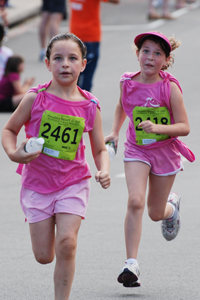A ‘revolution’ is brewing among girls who are learning the power of physical activity in their lives
October 27 2010

Arnold School graduate and
undergraduate students are
serving as mentors for the
fast-growing Girls on the Run
programs in the Midlands.
Dec. 5 is weeks away, but that date is already building excitement among the young women members of the Midlands area Girls on the Run (GOTR) programs.
That Sunday marks the next 5K run for members in the fast-growing GOTR effort that held its first run in the Columbia area in the spring of 2005.
GOTR started in 1996 in Charlotte and has spread to 160 sites across the country, serving more than 40,000 girls in grades 3-8 every year, said Mary Lohman, an MSW/MPH graduate student who is the director of the Girls on the Run of Columbia.
Helping girls become more active is just one focus of the international nonprofit program for “third, fourth, and fifth grade girls that uses the power of physical activity, life lessons, and positive mentoring to prepare girls for a lifetime of self-respect and healthy living,” according to its website.
Lohman, who is seeking her dual degrees in the Arnold School’s Department of Health Promotion, Education and the USC College of Social Work, says the GOTR program addresses common problems that fall into three classifications: lack of identity, lack of healthy peer support, and feelings of powerlessness.
Active in the GOTR effort since she was a high school student in Atlanta, Lohman worked with USC Exercise Science expert Dr. Russ Pate and other USC faculty members in planning and organizing the first club in Columbia.
The program probably would not have taken root in the Midlands without the support of the university and the dedication of volunteers such as Lohman, Pate said.
“I think Girls on the Run is a wonderful example of a way in which the university benefits the greater Columbia area,” he said.
Pate learned of the program at an academic conference and was impressed with the program’s dedication to providing young girls with an environment that encourages physical activity. “We all know that’s important but the less obvious impact in the positive impact the program has on their social skills and self-esteem,” he said.
The Columbia program, which includes Richland and Lexington counties, has grown rapidly over the past five years. There are now 13 teams in the area where more than 20 USC graduate and undergraduate students and faculty have served as volunteer coaches and assistant coaches during the past year.
The program is spreading to other locations around the state, said Lohman.
The Greenville Hospital System’s Children’s Hospital sponsors a chapter as does the YMCA of Anderson. A Tri-County chapter includes members from York, Chester and Lancaster counties and residents in Charleston also have shown interest in organizing a chapter, she said.
Lohman said she became interested in the program when she was running track and cross-country in high school. The athletic side of the program was the main appeal at first, but then the character-building aspect caught her attention.
GOTR clubs meet twice a week for 12 weeks every fall and spring; some of the girls sign up for both sessions or for more than one year. The 90-minute sessions focus on things such as members learning to respect themselves and others and to avoid gossiping and other bad habits.
The girls are encouraged to talk about their emotions and about how to handle real-life issues. “For instance, what would they do if they got into a car and found out the driver had been drinking,” Lohman said.
Erin Howie, a third-year Ph.D. student in Exercise Science, is in her second year of coaching a GOTR team. “The program is not about “times, paces or records, the girls just have to keep moving,” she said.
“We have three rules: 1. Only one person talks at a time (obviously with 22 girls!) 2. Be positive. 3. Always try your best,” Howie said.
“My favorite part about GOTR is the teamwork that slowly develops over the season. We have ‘energy awards’ at the end of practice, which the girls give out to a teammate(s) for something special they did,” she said. “It’s almost never about being the fastest runner or doing the most laps, but for not giving up, or helping another teammate, or trying your best.”
Health and nutrition information is an important part of the program that can also include silly games and as always, walking and running activities.
The capstone of each 12-week session is the 5K run. Lohman said that while the event is a challenge, most healthy, dedicated girls are able to finish the trek – walking or running. “The smiles on their faces at the finish are something to see,” she said.
Other GOTR volunteers have similar thoughts. Emily Herring, an undergraduate student in public health, is the volunteer head coach for the program at Rosewood Elementary School.
The experience “has been one of the most rewarding projects I have ever been part of,” Herring said. “Oftentimes, undergrads do not think they can really make a difference in their communities because they lack a degree. However, volunteering with projects like Girls on the Run is a terrific way to get involved in local communities and see public health practice in action.”
The hands-on experience in public health is essential for students who yearn to make a difference in health outcomes in the United States, Herring said.
“By teaching the girls valuable lessons about physical activity, nutrition, and social and emotional wellness, coaches can start a revolution in showing younger generations how to take responsibility for their own health,” she said.



_01.jpg)
_02.jpg)